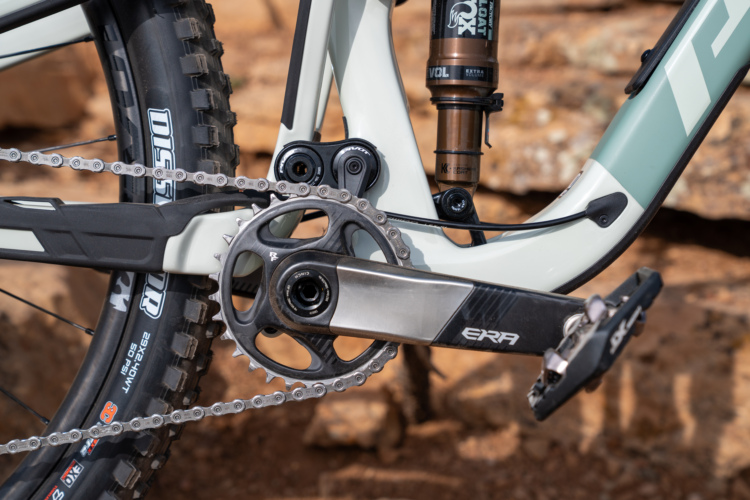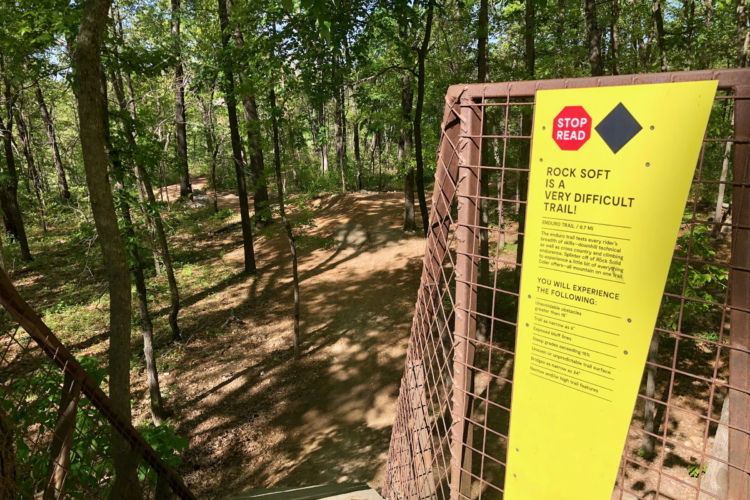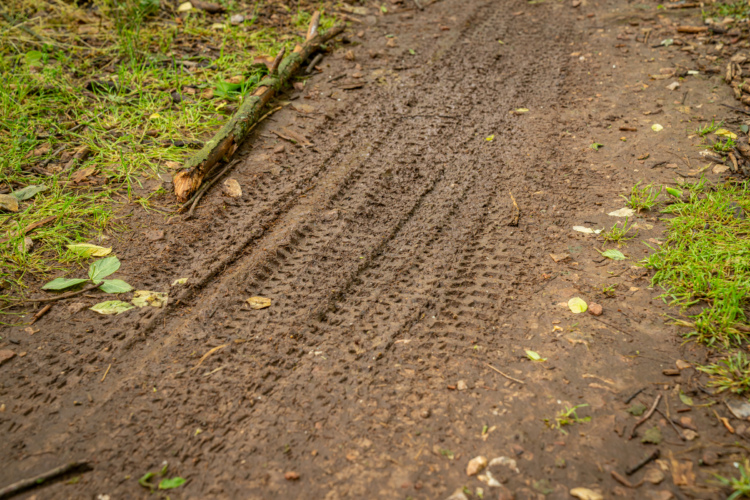Back in the 1990s, GT and their triple triangle designs were the name in performance mountain bikes, but then the company seemed to go quiet for several years. That’s been changing dramatically recently, especially in 2012 and 2013 with GT signing the Athertons to their Factory Racing team and the release of a number of all-new, high-performance mountain bikes, including the Sensor, the Force, and the Fury.
GT Force Carbon Pro Specs
Frame: Suspension
Featuring 150mm of rear suspension (paired with a 150mm fork), both of the GT Force models currently available feature full-carbon frames–there’s not so much as a single alloy offering for this model… at least not yet.
The rear linkage is extremely low on the bike and is built right around the bottom bracket, making for an extremely low-and-stable center of gravity.
Dubbed by GT as an “Angle Optimized Suspension (AOS) Independent Drivetrain,” the idea is to offer the best pedaling efficiency and bump compliance possible. For more deets on the suspension, check out this video from GT:
 While most suspension systems try to accomplish these same goals, GT, more than almost any other company, has really succeeded in getting the center of gravity (aka the rear shock, suspension linkage, and seat and chain stays) extremely low on the bike. As I mentioned in my Diamondback Sortie 3 29er review, “having most of the weight low and at the center of the bike [helps] it handle and ride like a much lighter bike. Many times people don’t consider weight distribution when comparing bikes but it is definitely important to think about.” And GT has put the bulk of the weight even lower than Diamondback did. Really, just look at the photos: the Force’s linkage can’t physically get lower, as it already incorporates the bottom bracket into it!
While most suspension systems try to accomplish these same goals, GT, more than almost any other company, has really succeeded in getting the center of gravity (aka the rear shock, suspension linkage, and seat and chain stays) extremely low on the bike. As I mentioned in my Diamondback Sortie 3 29er review, “having most of the weight low and at the center of the bike [helps] it handle and ride like a much lighter bike. Many times people don’t consider weight distribution when comparing bikes but it is definitely important to think about.” And GT has put the bulk of the weight even lower than Diamondback did. Really, just look at the photos: the Force’s linkage can’t physically get lower, as it already incorporates the bottom bracket into it!
Frame: Design and Paint
While the suspension design is pretty unique, what really sets this frame apart in my mind is its sheer beauty. Essentially every high-end mountain bike company makes bikes that ride and perform really well… but not all of them make bikes that perform well and are pleasing to look at. With the curvy carbon lines of the Force’s frame, not only is it functional, but is extremely good looking too!
When you look at the frame up close, you’ll realize that there’s not a single straight line in it. All of the tubes are curved and shaped, molded to provide as much stiffness as possible or to provide clearance for a certain component… or both.
The front triangle is incredibly stiff, with added supports at the head tube and seat tube, but those supports are crafted to seem both artistic as well as functional. The seat tube, where the rear triangle pivot connects and the shock passes directly through it, is a beautiful, massive, sculpted hunk of gorgeous carbon. Move on down to the rear chain stays with their flair and low-lying posture, and this bike frame truly looks like the wings of the bird that are painted on it.
The paint scheme on the Force Pro isn’t just a slapped-on afterthought, either. Every color change and wing accent is incorporated into the folds and trusses of the frame. The paint scheme was designed to utilize the frame’s shape in every way possible, making the aesthetics seem as much a part of the bike as the functional design itself.
Yeah, GT could have settled for just making a bike that rides well… but instead they decided to make a fantastic-riding bike that is worthy of being hung on the wall as art.
Frame: Geometry
My size-medium test bike features a 455mm seat tube length, 599mm top tube length, a 763mm stand over height, a 114mm head tube length, 9mm bottom bracket drop, and a 348mm bottom bracket height. However, thanks to a very short (60mm) stock stem, the reach is still quite reasonable.
The head tube angle comes in at 67.2 degrees and the seat tube angle at 73.8 degrees, meaning this is a slack bike that is definitely most comfortable while descending.
A 443mm chain stay length in all models, 43mm fork rake in all models, and a 1162mm wheel base in the size-medium model all show that GT didn’t attempt to make the wheelbase short. In fact, in the video above, GT talks about lengthening the wheelbase which is a bit out of the norm. The resulting super-stable, long bike feel is one of the first things I noticed when I hopped on the Force.
Stay tuned for my final review for a detailed analysis of how this geometry affects the demeanor and performance of the Force.

Component Spec
My stock, size-medium GT Force Carbon Pro weighs in at exactly 30 pounds. The component spec is definitely not designed with the lightest-weight components that money can buy, but since they are indeed expensive components, a premium has been consciously put on durability and performance over low weight.
The rear Fox Float CTD BV shock is paired with a burly Fox 34 Float 27.5 CTD FIT fork for full, supple Fox suspension.
The entire drivetrain is a 3×10 Shimano XT system with a Shadow Plus clutch-style rear derailleur. While I think that a clutch-style rear derailleur is absolutely necessary on a bike of this caliber at this point in time, the choice to go 3×10 is quite interesting. While a 2×10 or even an aggressive 1x system might seem more fitting, the 3×10 really helps to compensate for the weight and the burl of the bike by allowing the rider to spin up even the steepest of climbs.
The brakes, on the other hand, are Formula T1. This choice really confused me: the Formula brakes cost $349 per end, whereas Shimano XT brakes retail for $170 per end. Yes, Shimano XT brakes are literally less than half the price of the Formula brakes.
With such expensive brakes, I expected the Formulas to be absolutely superb. However, I’m only about 100 miles of riding into my review, and I have been completely underwhelmed with the Formula brakes. My test rig had been ridden before, and when I got the bike, I could tell that the brakes had significant air in the lines, and that the power wasn’t anything to brag about. I had them bled at my local shop, and then a couple days later, when I took the bike out for a ride, there was zero brake power. I took it back to the shop, got another bleed (for free), and right now they are feeling at least decent.
I’m interested to take them back out onto the trail to see how they perform (and if there’s more power available now), but I really wonder: why did GT spec Formula brakes when they could have rounded out their full XT kit with the bomber, time-proven, XT stoppers for over $350 less? Stay tuned to my final review for more information on these brakes, but so far, they’re the only complaint I have about this bike.
The entire rig rolls on e.thirteen TRS+ 650b wheels with a 21mm/26.4mm rim width and big 2.4″ Continental X-King tires. So far, I’ve been loving the tires, thanks to fantastic grip and reinforced sidewalls to guard against sidewall tears.
Rounding out the build kit are a RaceFace Turbine cockpit with 760mm-wide bars and 60mm-long stem, GT lock-on grips, a Fizik Gobi saddle, and a RockShox Reverb Stealth dropper post.
Stay Tuned…

I’ve already spent a good bit of time riding the GT Force Carbon Pro, and without giving too much away, I can say the Force is designed to be uncompromisingly burly and aggressive. It doesn’t mess around with pretenses of light duty: this is an all mountain bike that’s more than prepared for the extreme end of the MTB spectrum!
For full ride impressions, stay tuned for my final review in a couple of months!
MSRP: $7,050
Many thanks to GT Bicycles for sending the GT Force Carbon Pro over for review.






























19 Comments
Feb 4, 2014
Feb 6, 2014
Feb 4, 2014
Feb 4, 2014
What does bother me is how low the lever is on the shock. Good luck flipping that while riding, and not crashing. It needs a remote lever like the Scott, especially at that weight.
Also, for a $7000 bike, it is ridiculous to put a 3x10 drivetrain on it. If they make a long bike for descending, the slap a 28T XX1 on there and lighten the load. It has the gear ratio advantage for climbing as a 3x10.
I agree with the choice to go Formula. They make great brakes, but not those, and it was an unwise choice to spec that bike with anything other than XTs.
The bike is pretty, but GT has a reputation to build, and there are bikes with better parts for less money with similar geometry that already have a solid reputation: Norco Sight LE, Pivot Mach 6, Santa Cruz Bronson C...to name a few. They put too much thought into the aesthetics, and not enough into spec'ing the parts.
That bike is obviously not following the Enduro bandwagon. The long wheelbase definitely give it an advantage at speed, but longer chainstays suffer on switchbacks and over technical climbs. That begs the question: what type of ride was this bike build for??
Feb 4, 2014
I agree with this point 100%... more on that in the Final Review.
"If they make a long bike for descending, the slap a 28T XX1 on there and lighten "
Having just gotten off of a bike with a SRAM XO 1x11, I'll say that the 1x11 system definitely does sacrifice low-end gearing compared to a 3x10. I can spin up much steeper hills on the Force than I could on the previous test rig. However, I will agree that it doesn't seem to fit with the overall design of the bike: going downhill fast. Maybe they included a 3x10 to counteract some of that all-aggressive downhill power?
"That bike is obviously not following the Enduro bandwagon. The long wheelbase definitely give it an advantage at speed, but longer chainstays suffer on switchbacks and over technical climbs. That begs the question: what type of ride was this bike build for??"
I'm not sure where you're going with this comment. Since Enduro races are timed only on the descents, suffering a bit on tight switchback climbs in order to descend better seems EXACTLY in line with enduro racing. And as you just mentioned above, there are already plenty of great offerings in this niche... so why would GT want to "follow the bandwagon" ?
Actually, I think this bike is perfectly slated for enduro racing. A lot of other all-mountain bikes seem to really shoot to be a one-quiver bike. The GT Force doesn't seem to do that, and instead focuses on aggressive descending, while still keeping the climbs manageable. With a lot of enduro stages being held at ski resorts on runs that are often relegated to full-blown downhill rigs with 8" of travel and dual crown forks, a bike that is more descending centric, while still being competent enough on the climbs, seems like the ideal bike for these kinds of races.
I plan to race the Big Mountain Enduro series this summer, and I think the GT Force is the bike for the job. I'll be sure to report back on how it goes!!
Feb 4, 2014
That being said, the idea of this bike isn't junk. I think it caters to a different riding style, and my question: "what type of ride(r) was this bike build for??" was really more rhetorical. I think it fills a niche for enduro/AM/trail who like a more stable bike at speed, and don't mind sacrificing what I mentioned above. And that isn't the bandwagon, which we both pointed out. It's a bold move by GT, and I like it, because it may catch on and continue to bump out the market even more than it already has for "enduro-style" riding. What I am really worried about with this particular bike are the unusual parts choices I mentioned. It's one thing to tweak the riding style, but another one to start putting parts on a bike that deviate greatly from where the market is headed, and what marketers tell us we should ride (ah-ha). The XO-1 can only accommodate a 30T, but the XX1 allows a tiny 28T, which is the same gear ratio as the granny on a 3x10. Some enduro riders will want the a 1x setup for the reasons they have always wanted one (quiet, simplicity, etc..) at the expense of top end speed if you put a small 28T on it. But I think that GT recognized that having more gears gives a bigger top end range...but a 3x10 is just a weird choice. Unsettling. Don't they know how many redundant gears are on a 3x10? So why not go with a 2x10? It is just strange, and maybe embarrassing. Another site did a final review of this bike, and the comments about the GT were brutal....and spot on. But, don't get me wrong: I think the frame is awesome. The suspension is interesting. The wheels are stellar. But I have questions, and lots of them, if this is for a burly, huckin', enduro bike that can hang with the DH bikes:
-why not design it to spec a double barrel shock on the frame. You could never put one on it the way the shock is mounted.
-A KS LEV would have been a better choice than a RS Reverb
-I already beat the 3x10 thing to death
-A Rockshox Pike would have been a better choice than the Fox for Enduro. I run a Fox 29Talas 34 140mm on my bike, and love it, but every single review (I mean all of them) of the Pike seems like it dominates the Fox 34s on the Enduro circuit. Pro guys are switching over left and right
But what do I know...I'm just an armchair engineer that reads too much and rides too little. Go ride the bike and tell us how awesome it is in the real world and not on paper, because I hope I am dead wrong. :)
Feb 4, 2014
Have you contacted Formula about them? They may be more helpful than your local shop.
Feb 4, 2014
Feb 6, 2014
If you want something that turns quicker look at the Sensor. Sorry but the Force is an example what's happening in 2014. I feel the beautique brands have been working this way for a while, but Giant and GT have made big changes in geometry with their new 27.5" bikes. Having talked to the Army guys coming back from Germany I think they are bigger over there, and the new Force seems to fit their AM riding quite well. GT maintains that aftermarket sales of triples are high, and hence why all their bikes come with triples. Also, from what I understand the trails at least in the part of Gemany these guys gets stationed, and where one of the soldier brother-in-laws comes from (he came to visit and couldn't stop riding Rotary Park) the trails don't seem to switchback up much, they are in or near the Alps, and will do long rides. But they want the big bike for the descents. Read Bike Radar's reviews of the bike. They love it, but panned the Sensor because it wasn't the Force (which still makes no sense to me). Also over at MTBR, or BikeMag, or where ever all you hear is how people need a 67 degree HTA, a 50mm stem, and 780 plus wide bars. OK, I'm stereotyping. This bike fits the needs of what a lot of people are saying they want. I'm riding a Sensor, and like you I like a quicker handling bike, and this is the ticket. I do have a sneeking suspicion that if you could get a Force down to the same weight as Giant Trance Advanced the Force would climb better. But that's just conjecture.
Lets also not forget that aboard the right riders the new Carbon Force finished off the season from the 2013 Force LE and netted 2nd in the women's class, 1st in the Junior's and 3rd in the Men's overall in the Enduro World Series this year. It's clearly not slowing anyone down.
Nov 21, 2016
Feb 7, 2014
Feb 6, 2014
http://www.gtbicycles.com/news/martin-maes-smashes-the-1st-enduro-world-series-to-take-the-junior-title-overall/
May 4, 2014
May 4, 2014
Feb 6, 2014
Not to beat a dead horse, but just remembered this. For some reason not on the international site but the UK gets the Force X with 160mm forks and double barrel shocks. All Fox. And they have 2X10 drivetrains. I think those would have been better bikes for the US market if you are only going to sell carbon versions.
Feb 6, 2014
Feb 7, 2014
As for the 3 ring crank...personally, I still really like my 3ring crank. If I'm going to have gears on the front, might as well have the biggest range possible. I spend 99% of my time in middle ring, but when I need/want the other two, I'm glad they're there. With a 2x ring I have to shift too much up front. I would be happy with a 1x though. But, nothing else offers the same range as a 3 ring crank. yeah you can get the same low gear, or high gear, with another system, but nothing has the range of a 3 ring crank.
Feb 7, 2014
Feb 7, 2014